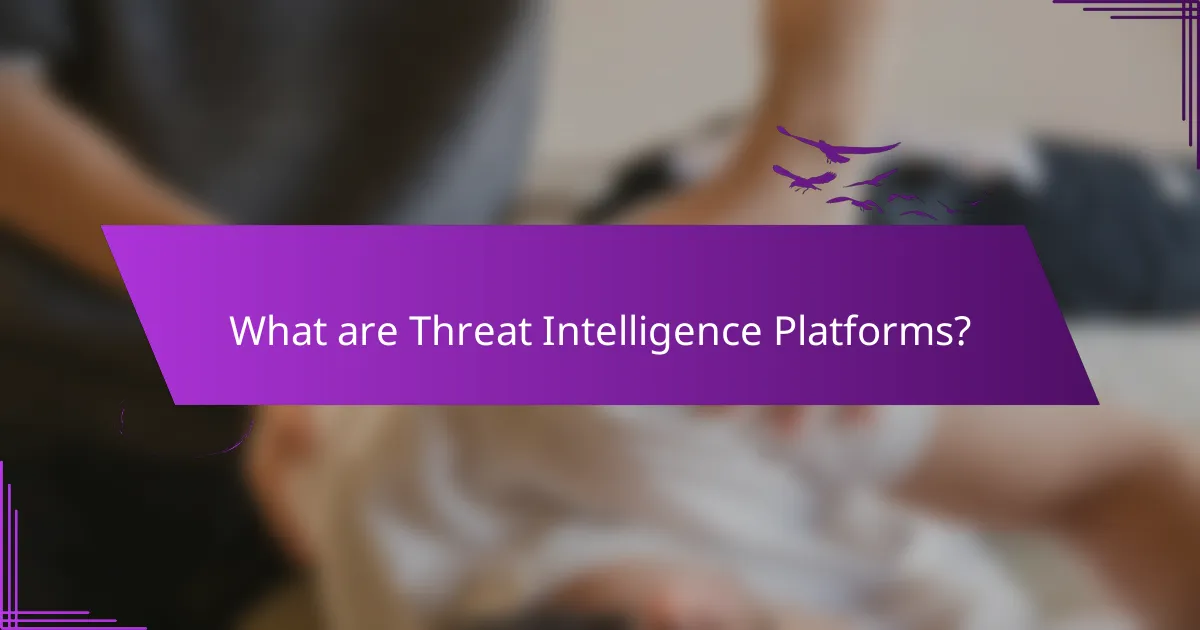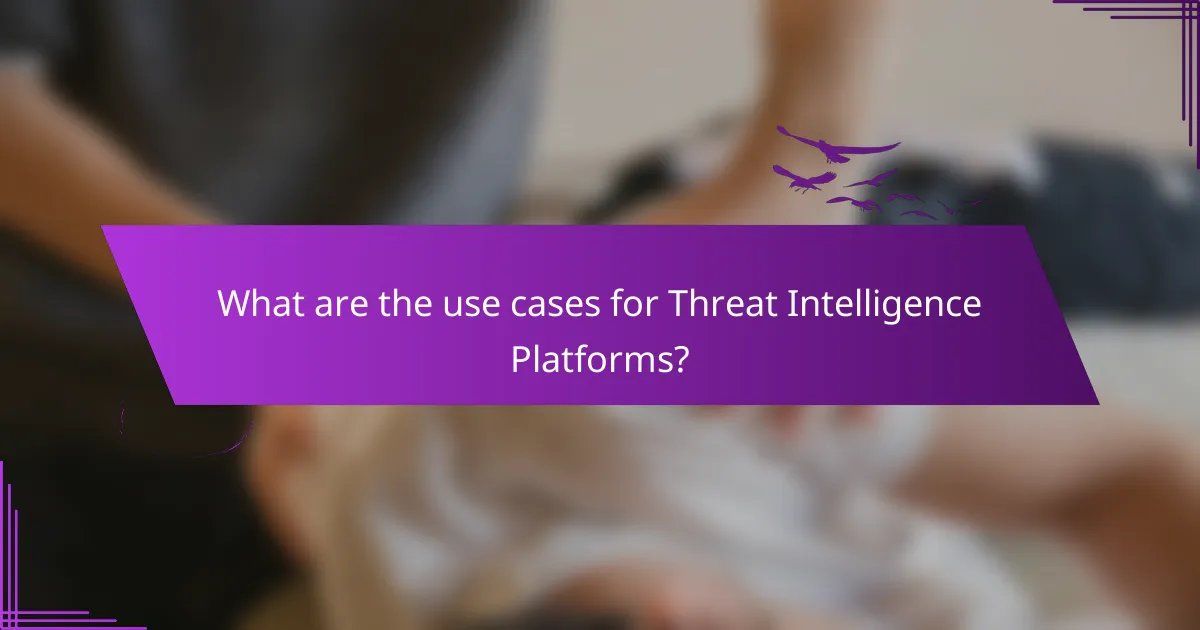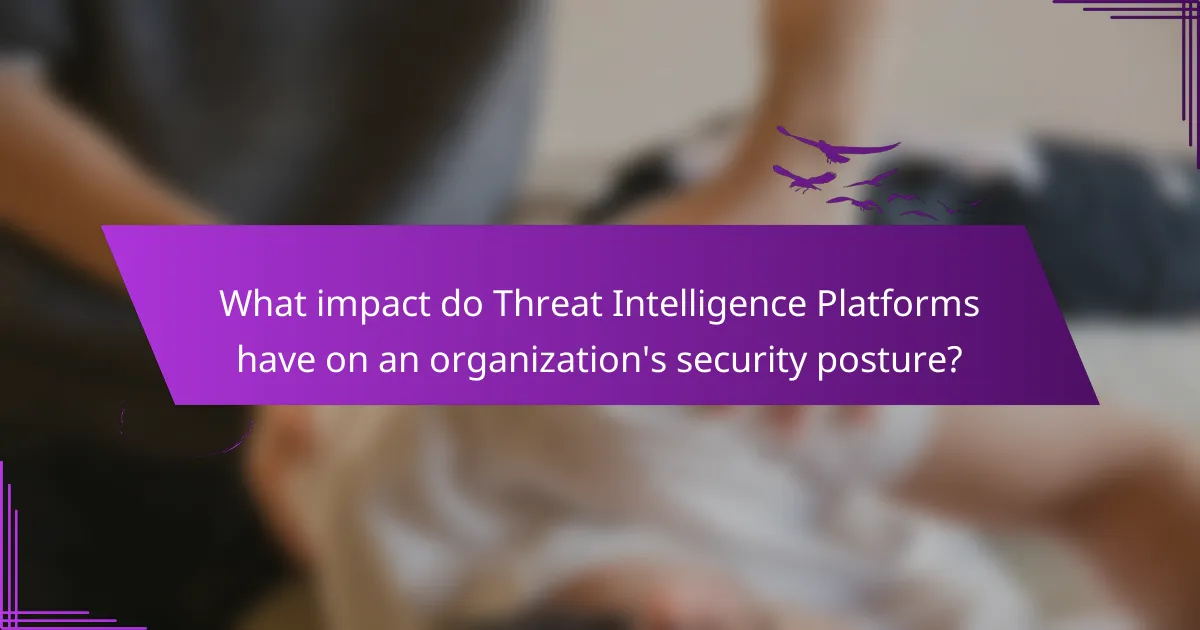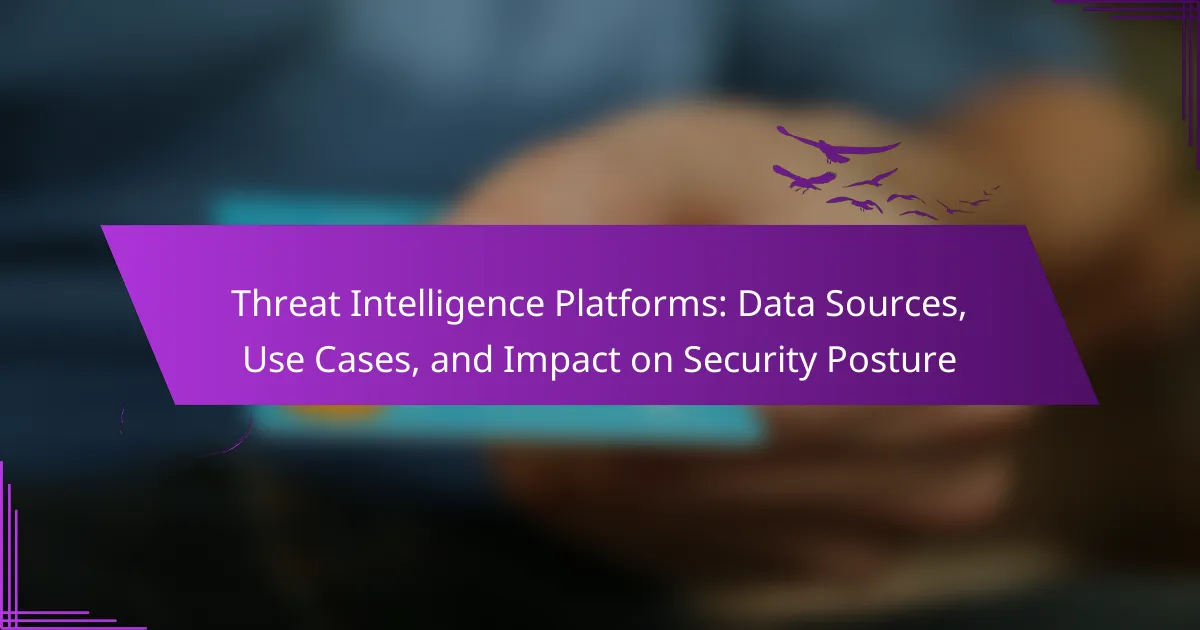
What are Threat Intelligence Platforms?
Threat Intelligence Platforms (TIPs) are tools that aggregate, analyze, and manage threat data. They provide organizations with actionable intelligence to enhance cybersecurity. TIPs help in identifying potential threats by collecting data from various sources. This includes open-source intelligence, commercial feeds, and internal data. They enable security teams to respond effectively to threats. TIPs also facilitate collaboration among different security tools and teams. According to a report by Gartner, organizations using TIPs can improve their incident response time by up to 30%. This demonstrates the value of TIPs in strengthening security posture.
How do Threat Intelligence Platforms operate?
Threat Intelligence Platforms (TIPs) operate by aggregating and analyzing threat data from various sources. They collect information from internal and external feeds, including open-source intelligence, human intelligence, and commercial sources. TIPs normalize this data to create a unified view of threats. They utilize machine learning and analytics to identify patterns and trends in the data. This process helps organizations understand potential vulnerabilities and threats. TIPs also facilitate automated responses to detected threats. By integrating with security tools, they enhance incident response and proactive defense strategies. Their effectiveness is supported by real-time data updates and community sharing of threat intelligence.
What are the key components of Threat Intelligence Platforms?
Key components of Threat Intelligence Platforms include data collection, analysis, and dissemination. Data collection involves gathering information from various sources such as open-source intelligence, internal security data, and commercial threat feeds. Analysis refers to the processing and interpretation of the collected data to identify threats and trends. Dissemination is the distribution of analyzed intelligence to stakeholders for informed decision-making. Additionally, integration capabilities with existing security tools enhance the platform’s effectiveness. Reporting features provide actionable insights and facilitate communication across teams. These components work together to improve an organization’s security posture by enabling proactive threat management.
How do these components interact within Threat Intelligence Platforms?
Threat Intelligence Platforms integrate various components to enhance cybersecurity. These components include data sources, analytics engines, and user interfaces. Data sources provide raw threat data, such as indicators of compromise. The analytics engine processes this data to identify patterns and generate actionable insights. User interfaces allow security teams to visualize and interact with information.
Data sources interact with the analytics engine by feeding raw data for analysis. The analytics engine then correlates this data, identifying potential threats. Insights generated are displayed through user interfaces, enabling informed decision-making. This interaction streamlines threat detection and response processes.
For example, a study by Gartner highlights that organizations using integrated threat intelligence platforms reduce incident response times by up to 50%. This demonstrates the effectiveness of component interaction within these platforms.
What are the primary types of data sources used in Threat Intelligence Platforms?
The primary types of data sources used in Threat Intelligence Platforms include open-source intelligence (OSINT), commercial threat feeds, internal telemetry, and information sharing communities. OSINT involves publicly available information from various online sources. Commercial threat feeds provide curated threat data from vendors. Internal telemetry refers to data collected from an organization’s own systems and networks. Information sharing communities consist of collaborative groups that exchange threat intelligence among members. These data sources collectively enhance the situational awareness and response capabilities of security teams.
How do open-source intelligence and commercial data sources differ?
Open-source intelligence (OSINT) and commercial data sources differ primarily in accessibility and cost. OSINT is publicly available information gathered from sources like websites, social media, and government publications. It is free to access and can provide valuable insights into various subjects. In contrast, commercial data sources require payment for access and often offer specialized, curated data. These sources may include proprietary databases, market research, and subscription services. OSINT is typically broader but less specific, while commercial data can be tailored to specific needs. Commercial data sources often provide higher accuracy and reliability due to their vetted nature. This distinction underscores the varying applications and strategic uses of both data types in threat intelligence.
What role does internal security data play in Threat Intelligence Platforms?
Internal security data is crucial for Threat Intelligence Platforms (TIPs). It enhances the accuracy of threat detection and response. Internal data includes logs, alerts, and incident reports. This data provides context for understanding threats specific to an organization. TIPs analyze this information to identify patterns and anomalies. By integrating internal security data, organizations can improve their situational awareness. Enhanced situational awareness leads to faster and more effective incident response. Thus, internal security data significantly strengthens the overall security posture of organizations using TIPs.

What are the use cases for Threat Intelligence Platforms?
Threat Intelligence Platforms (TIPs) are used for various purposes in cybersecurity. They help organizations aggregate threat data from multiple sources. This data can be analyzed to identify potential security threats. TIPs also facilitate sharing of threat intelligence within and between organizations. They enhance incident response by providing context to threats. Additionally, TIPs support proactive threat hunting activities. They allow for the automation of threat detection processes. Furthermore, TIPs assist in compliance reporting by providing documented threat intelligence.
How can organizations leverage Threat Intelligence Platforms for proactive security?
Organizations can leverage Threat Intelligence Platforms (TIPs) for proactive security by integrating real-time threat data into their security operations. TIPs aggregate, analyze, and disseminate threat information from multiple sources. This enables organizations to identify potential threats before they materialize. By utilizing TIPs, organizations can enhance their incident response capabilities. They can also automate threat detection and prioritize vulnerabilities based on risk levels. Furthermore, TIPs facilitate collaboration between security teams and external threat intelligence providers. This collaborative approach improves overall situational awareness. According to a report from Gartner, organizations using TIPs can reduce incident response times by up to 40%.
What specific security threats can be mitigated using Threat Intelligence Platforms?
Threat Intelligence Platforms can mitigate various security threats, including malware attacks, phishing attempts, and advanced persistent threats (APTs). These platforms aggregate and analyze threat data to identify vulnerabilities. They provide real-time insights into emerging threats, enabling proactive defense measures. For instance, they can detect indicators of compromise (IOCs) associated with known malware strains. Additionally, they enhance incident response by correlating threat intelligence with existing security tools. By leveraging threat intelligence, organizations can reduce the risk of data breaches and improve overall security posture.
How do Threat Intelligence Platforms enhance incident response capabilities?
Threat Intelligence Platforms enhance incident response capabilities by providing real-time data on threats. They aggregate and analyze information from various sources. This allows security teams to identify potential risks quickly. Enhanced situational awareness leads to faster decision-making during incidents.
For example, platforms can deliver indicators of compromise (IoCs) to inform response strategies. They also enable proactive threat hunting by highlighting emerging threats. Integration with existing security tools streamlines incident response workflows. Research shows that organizations using these platforms can reduce incident response times significantly.
What industries benefit the most from Threat Intelligence Platforms?
The industries that benefit the most from Threat Intelligence Platforms include finance, healthcare, government, and technology. The finance sector relies heavily on threat intelligence to protect sensitive financial data and prevent fraud. Healthcare organizations use these platforms to safeguard patient information and comply with regulations. Government agencies utilize threat intelligence to defend against cyber threats and enhance national security. The technology industry leverages these platforms to secure software and infrastructure from emerging threats. According to a report by Cybersecurity Ventures, cybercrime is projected to cause $10.5 trillion in damages annually by 2025, highlighting the critical need for threat intelligence across these sectors.
How do regulatory requirements influence the use of Threat Intelligence Platforms in various sectors?
Regulatory requirements significantly influence the use of Threat Intelligence Platforms (TIPs) across various sectors. Compliance with regulations often necessitates enhanced security measures. For instance, sectors like finance and healthcare are subject to strict data protection laws. These laws compel organizations to adopt TIPs to monitor and mitigate threats effectively.
Moreover, regulations such as GDPR and HIPAA mandate the safeguarding of sensitive information. This leads organizations to utilize TIPs for real-time threat detection and response. Additionally, failure to comply with these regulations can result in substantial fines and reputational damage. Therefore, the adoption of TIPs is not only a strategic choice but also a regulatory necessity in many industries.
What unique challenges do different industries face when implementing Threat Intelligence Platforms?
Different industries face unique challenges when implementing Threat Intelligence Platforms (TIPs). The financial sector often deals with regulatory compliance issues. These regulations require stringent data handling and reporting standards. The healthcare industry struggles with integrating TIPs into legacy systems. Many healthcare organizations have outdated technology that is not compatible with modern TIPs.
Retail businesses often face challenges related to data volume and diversity. They handle vast amounts of customer data, which can complicate threat analysis. The manufacturing sector frequently encounters supply chain vulnerabilities. These vulnerabilities can be difficult to monitor and manage effectively.
Government agencies may face bureaucratic hurdles in adopting TIPs. These hurdles can slow down the implementation process and limit responsiveness. In contrast, technology companies often grapple with the rapid evolution of threats. They need to continuously update their TIPs to stay ahead of emerging threats.
Understanding these challenges is crucial for effective TIP implementation across various industries. Each sector must tailor its approach to address its specific obstacles.

What impact do Threat Intelligence Platforms have on an organization’s security posture?
Threat Intelligence Platforms significantly enhance an organization’s security posture. They provide timely and relevant information about emerging threats. This information allows organizations to proactively identify vulnerabilities. By integrating threat intelligence, organizations can improve incident response times. They can also prioritize security measures based on real-time data. According to a study by the Ponemon Institute, organizations using threat intelligence experience a 27% reduction in security incidents. This demonstrates the effectiveness of these platforms in mitigating risks. Overall, Threat Intelligence Platforms are crucial for strengthening security frameworks.
How do Threat Intelligence Platforms contribute to risk management?
Threat Intelligence Platforms (TIPs) enhance risk management by aggregating and analyzing threat data. They provide organizations with actionable insights on potential vulnerabilities and threats. This enables proactive identification and mitigation of risks before they escalate. TIPs facilitate informed decision-making by delivering real-time threat intelligence. They also improve incident response times by equipping security teams with relevant information. According to a report by Gartner, organizations using TIPs can reduce the time to detect threats by up to 50%. By integrating threat intelligence into risk management frameworks, organizations can strengthen their overall security posture.
What metrics can be used to measure the effectiveness of Threat Intelligence Platforms?
Metrics to measure the effectiveness of Threat Intelligence Platforms include accuracy, timeliness, and relevance of threat data. Accuracy refers to the precision of the intelligence provided. Timeliness measures how quickly the intelligence is delivered after a threat is identified. Relevance assesses how applicable the intelligence is to the organization’s specific environment. Additional metrics include the number of incidents detected, false positive rates, and user satisfaction scores. These metrics help organizations evaluate the performance and impact of their Threat Intelligence Platforms on overall security posture.
How do Threat Intelligence Platforms improve overall organizational resilience?
Threat Intelligence Platforms (TIPs) enhance organizational resilience by providing timely and actionable threat data. They aggregate threat intelligence from various sources, including open-source feeds and private reports. This data helps organizations identify potential vulnerabilities and threats in real-time. By analyzing and correlating this information, TIPs enable proactive security measures. Organizations can respond to threats more effectively, reducing the impact of security incidents. A study by Gartner indicates that companies using TIPs experience a 50% reduction in incident response times. This efficiency leads to improved operational continuity and overall resilience against cyber threats.
What are the common challenges in adopting Threat Intelligence Platforms?
Common challenges in adopting Threat Intelligence Platforms include integration issues, data quality concerns, and cost constraints. Organizations often struggle to integrate these platforms with existing security tools. This can lead to fragmented threat data and inefficient workflows. Data quality is another significant challenge. Inaccurate or outdated threat intelligence can result in misguided security strategies. Additionally, the costs associated with implementing and maintaining these platforms can be prohibitive for some organizations. A report by Gartner indicates that 60% of organizations cite budget limitations as a barrier to effective threat intelligence adoption. Training staff to effectively utilize these platforms also poses a challenge, as a skilled workforce is essential for maximizing their potential.
How can organizations overcome integration issues with existing security tools?
Organizations can overcome integration issues with existing security tools by implementing standardized APIs. Standardized APIs facilitate communication between different security solutions. This approach allows tools to share data seamlessly. Additionally, organizations should prioritize tools that support interoperability. Using platforms that are designed for integration can reduce compatibility issues. Regularly updating security tools also helps maintain compatibility. Conducting thorough testing during integration phases is essential. This ensures that tools function correctly together. Lastly, engaging with vendors for support can provide solutions to specific integration challenges.
What are the best practices for maximizing the value of Threat Intelligence Platforms?
To maximize the value of Threat Intelligence Platforms, organizations should implement several best practices. First, integrate threat intelligence with existing security tools. This enhances the contextual understanding of threats. Second, prioritize actionable intelligence over raw data. Actionable insights lead to timely responses. Third, ensure continuous updates to threat intelligence feeds. Regular updates keep the information relevant and accurate. Fourth, train staff on interpreting threat intelligence effectively. Skilled personnel can leverage insights for better decision-making. Fifth, collaborate with external threat intelligence sharing communities. This expands the knowledge base and enhances threat detection capabilities. Lastly, regularly assess and adjust threat intelligence strategies. Ongoing evaluation ensures alignment with evolving threats. These practices collectively improve the effectiveness of Threat Intelligence Platforms in enhancing security posture.
What practical steps can organizations take to implement Threat Intelligence Platforms effectively?
Organizations can implement Threat Intelligence Platforms effectively by following several practical steps. First, they should define clear objectives for their threat intelligence initiatives. This helps in aligning the platform’s capabilities with organizational goals. Next, they need to assess their current security infrastructure. Understanding existing tools and processes is crucial for integration.
Training staff on the platform is essential for effective use. Employees must be familiar with the platform’s features and functionalities. Organizations should also establish partnerships with threat intelligence providers. Collaborating with external sources enhances the quality of intelligence gathered.
Regularly updating the platform is necessary to keep up with evolving threats. Organizations should schedule routine assessments and updates to their threat intelligence data. Finally, they must measure the effectiveness of the platform through key performance indicators. This evaluation helps in refining strategies and improving overall security posture.
Threat Intelligence Platforms (TIPs) are specialized tools designed to aggregate, analyze, and manage threat data, providing organizations with actionable intelligence to enhance their cybersecurity measures. This article covers the operation of TIPs, key components, and the various data sources utilized, including open-source intelligence, commercial feeds, and internal security data. It also explores the use cases for TIPs across different industries, their impact on security posture, and the challenges organizations face during implementation. Additionally, the article outlines best practices for maximizing the effectiveness of TIPs and practical steps for successful implementation.
